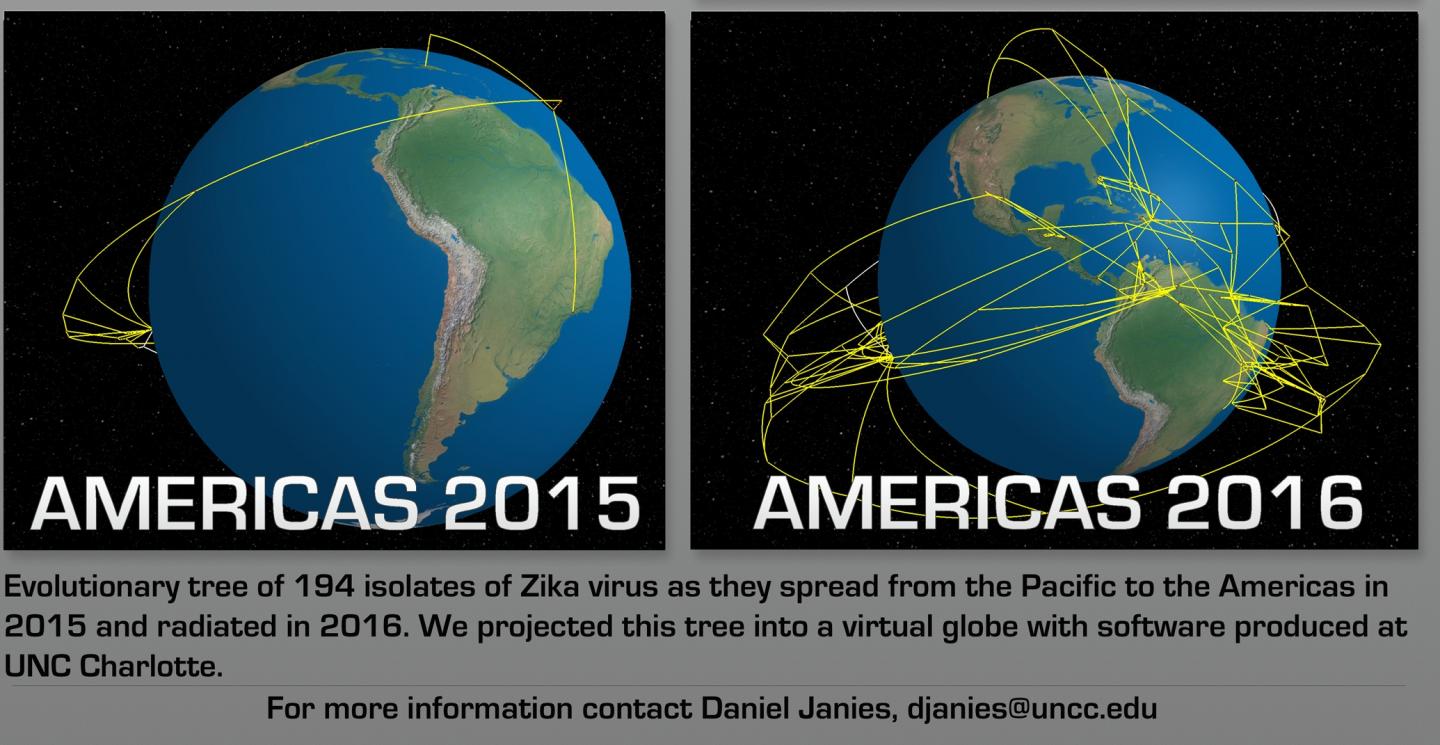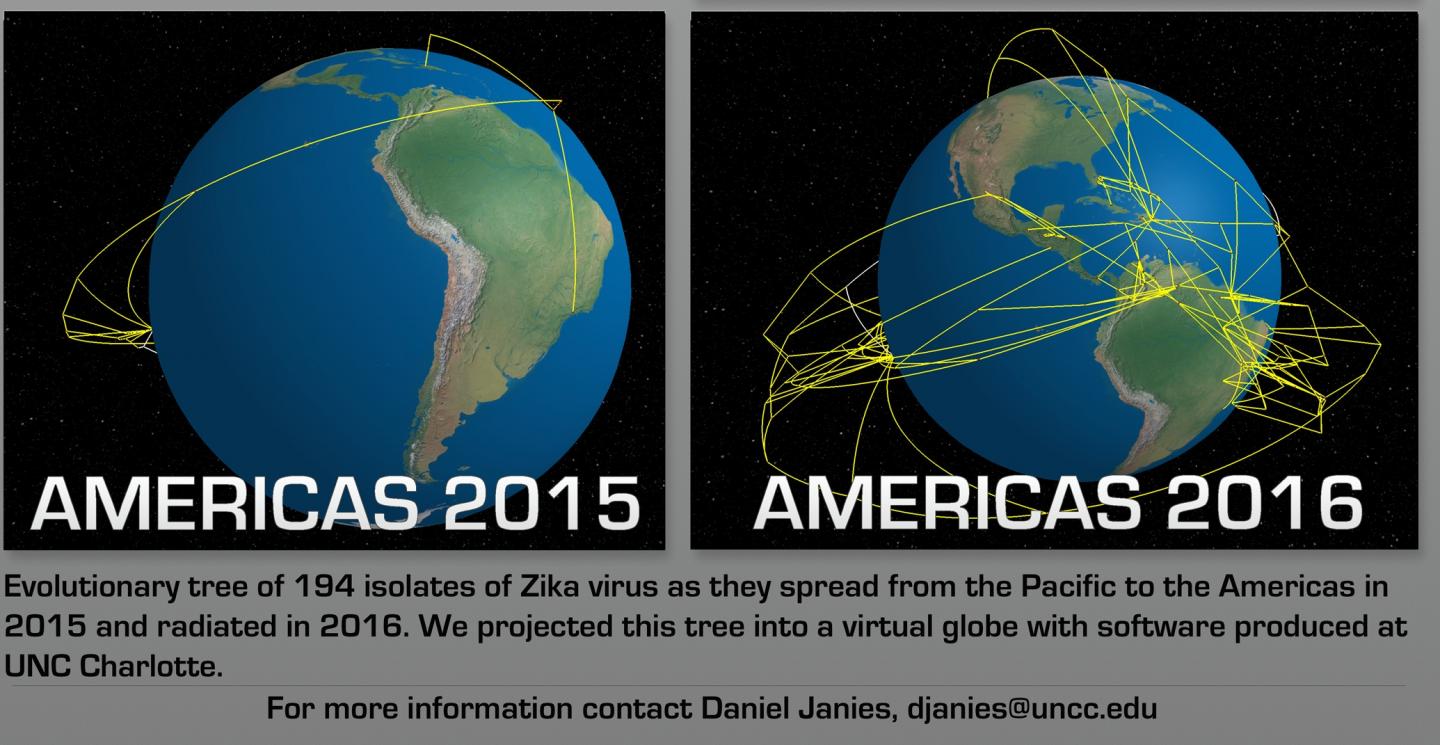
Credit: Daniel Janies
The Zika virus remains a mystery. Isolated from macaque monkeys in the Ziika Forest in Uganda in 1947, the virus was shown to infect humans not long after, but it was identified as a benign disease, with mild symptoms. For this reason, it was not heavily studied until almost 70 years later when it appeared to be associated with an unusual cluster of cases of microcephalic birth defects and Guillain-Barré Syndrome (GBS) paralysis in Brazil in 2015 and 2016.
If the at-least-70-year-old virus is responsible for the recently reported neurological diseases, why were the first serious effects not noticed until recently? And, why were these effects first in Brazil, very distant from its continent of apparent origin, Africa? The mysterious history of the virus matters because its details might tell us the backstory of how it came to be what it is where it is and from that, why it is doing so much damage.
But, how do you know the history of an invisible virus, which leaves no physical record? It is especially hard to know the history of Zika because the seemingly benign disease has been under-the-radar for most of its known time in human hosts.
This is where genetics can help, since single-strand RNA viruses like Zika tend to change rapidly over time and, with bioinformatics, researchers can deduce what the ancestral relationships are between different viruses collected at different places in different times from different hosts. While the first noted occurrence of the virus was in Africa, it was detected only a few years later in Asia, and separate lineages of the disease are known from both areas – a clue that the history hidden in the genes may be complicated.
"But sequence data on Zika is limited," notes University of North Carolina at Charlotte Bioinformatics and Genomics Professor Daniel Janies. "People have made the assumption that it came out of Africa because that's where it was discovered. However, it has not been easy to reconstruct the history of Zika with the data we have," he said.
Janies heads a team of researchers who have recently completed a phylogenetic and geographic analysis of the available collection of Zika's genetic sequences. The analysis provides the most complete study of the virus's history to date and reveals specific genetic changes that occurred as the virus crossed the Pacific Ocean on its way to the Americas. An analysis of the genes involved also suggests new hypotheses to explain the virus's association with microcephaly and GBS.
A report by Janies, Adriano de Bernardi Schneider, Jun-tao Guo, Gregorio Linchangco, Zachary Witter, Dylan Vinesett and Lambodhar Damodaran from the department of Bioinformatics and Genomics at UNC Charlotte, Robert Malone from Atheric Pharmaceutical, and Jane Homan from IoGenetics LLC appears in the current issue of Cladistics.
"Our results indicate that Zika may have deep ancestry in Asia that has been under-recorded," Janies said. "For example, not all the recent global outbreaks of Zika appear to result from a simple linear chronology of travel from the most recent past outbreak."
"Recently there has been an outbreak of Zika in Singapore in parallel to the one in the Americas. We have updated our analyses and the Singapore Zika virus is distantly related to the viral lineage in the Americas. This lends support for the hypothesis that there are yet-to-be discovered reservoirs of Zika virus in Asia," Janies said.
The Cladistics report traces Zika's phylogenetic tree through analysis of genetic sequences, combining it with the chronology and geographic information from the samples, and allows the researchers to detail the virus' probable historical path as well as specific genetic and structural changes in the virus as it traveled to the Americas.
The researchers noted in particular some new mutations that began appearing in the virus as it travelled from island to island across the Pacific. Not long after these mutations appear, there are records in French Polynesia of an increase in both microcephaly and GBS. The specific nature of the new mutations in the virus also suggest to the team some possible relationships between viral infection and the severe symptoms associated with the virus in the Americas.
"We looked at the viral changes that correspond to the first reports of microcephaly and we saw the origins of these changes in the Pacific lineages," Janies noted. "There are mutations that occurred in the part of the viral genome that codes the viral envelope protein and the ends of the viral genome that are called 'untranslated regions.' We focused on the envelope protein because that's the part responsible for the entry of the virus to host's cells. We studied the untranslated regions since they mediate the types of tissues the virus attacks and viral replication."
Both sets of mutations suggested potential relationships to the virus's new association with neurological and developmental problems in adults and infants.
"Members of our team found that Zika has recently started making its envelope proteins with features, called epitopes, that are similar to human proteins, which could cause a human host immune response to the virus to be diluted," Janies said. "The theory underlying this idea is called 'epitope mimicry.' The similarity is advantageous to the virus because it confuses the host's immune system and blunts the immune reaction to the virus."
However, the researchers suspect that the human proteins being mimicked may be significant for reasons besides providing immune system "cover" for the attacking virus.
An important element of the envelope protein mutation, Janies points out, is not only in the mimicry itself, but also, in the specific genes being mimicked: "Our team members found that two of the human proteins that Zika is mimicking are involved in the signaling that goes on when the sensory organs are being formed in the fetus. These genes are called 'Neuron Navigator Protein 2' and 'Human Neurogenic Differentiation Factor 4', " he said.
"Because these are the proteins are being mimicked, a hypothesis is that the developmental pathways that rely on the proteins may be being disrupted by the immune system," Janies said.
The other mutations, on the untranslated regions, suggest other possible effects that might change where Zika virus infects in the body.
"Although epitope mimicry hypothesis helps clarify the protein-immune interaction, the mutations in the untranslated regions may explain the types of tissues Zika attacks" UNC Charlotte Bioinformatics and Genomics graduate student Adriano de Bernardi Schneider said. "The presence of specific binding regions on untranslated regions of the Zika viral genome, called "Musashi Binding Elements" provides bases for the study of changes in tissue preference of the virus."
In this part of the study, the authors evaluated the changes in the virus' Musashi Binding Elements and found that they increased the efficiency of the Zika virus that is circulating in the Americas in hijacking human cells.
Musashi is a family of RNA-binding proteins in the host cells that control gene expression and the development of stem cells. The finding that Zika has mutated to be better at binding to human Musashi proteins, leads to the hypothesis that Zika is adapting to be more efficient at attacking human cells. Moreover, the role of Musashi proteins in stem cells provides another possible target for the study of developmental defects in the fetus associated with Zika infection in pregnancy.
Both the autoimmune effect and changes in the virus' tissue specificity are working hypotheses suggested by computational models and will require further study to verify.
In contrast, the information gained from studying Zika's phylogenetic history is of immediate importance to medicine and public health response, as this work puts the mutations in specific time and place context, at a time when the virus has nearly circled the planet, changing from place to place in its travels and leaving different variants. Many versions of the virus currently exist globally and these variants have different capabilities and effects.
"We're tracing the lineages and the geographic links in a very rigorous way and pulling it all together, pin-pointing Zika's molecular changes in time and space – showing what actually is going on in different places," Janies said.
"Why does it matter? Well, when Zika arrives someplace is it going to be benign or dangerous? It has been both — it depends on where it is coming from."
###
The full paper can been seen at: http://onlinelibrary.wiley.com/doi/10.1111/cla.12178/epdf .
This research study is based upon work supported by the Defense Advanced Research Projects Agency (DARPA) Program Simplifying Complexity in Scientific Discovery (SIMPLEX) and Space and Naval Warfare Systems Center, Pacific (SSC Pacific) under Contract No. N66001-15-C-4039 and by the UNC Research Opportunities Initiative grant to UNC Charlotte, NC State University, and UNC-Chapel Hill.
Source: Daniel Janies, 704-687-1742, [email protected]
Media Contact
James Hathaway
[email protected]
704-687-5743
@unccresearch
http://www.uncc.edu





